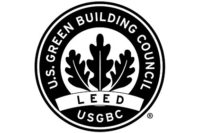We are bombarded with media stories and “public health” activist groups that claim we are living in a toxic soup, unavoidably exposed to unsafe chemicals found in products and materials that we regularly use and rely upon. The campaign to eradicate these so-called toxic chemicals from our everyday lives has reached a fever pitch. Rules, regulations and legislation are being proposed that would eliminate these substances merely because they might pose a hazard or risk, without any requirement to scientifically verify what, or how much, is actually present.
The USGBC has been wrestling with this since it first introduced the LEED rating system. The USGBC commissioned a study that examined how PVC fared environmentally against a handful of alternative building materials and discovered that, “No single material shows up as the best across all the human health and environmental impact categories, nor as the worst.”
It further concluded that “PVC performs better than several material alternatives studied, regardless of life cycle scope.” And finally, the report concludes that rewarding avoidance of PVC “could steer decision makers toward using materials that are worse on most environmental impacts.” Undeterred by the conclusions made in its own report, the USGBC continues its quest to develop a materials avoidance credit in LEED. The currently proposed credit would reward use of building products and materials that meet the requirements of the European Commission’s Registration, Evaluation, Authorization, and Restriction of Chemicals program.
PERCEPTION VS. REALITY
Nobody wants to harm themselves or anyone else by using something that is potentially dangerous, knowingly or unknowingly. We are fear-driven creatures. And it is because of this, that we are so heavily influenced by the media and our fears about the nasty chemicals surrounding us. An internet search for news stories about toxic chemicals brings up scary headlines like: “Toxic chemicals from supermarket labels seep through packaging and contaminate food,” and “Study: Toxic chemicals found in gardening tools.” What these articles do not talk about is that most chemicals that human beings are in contact with do not actually pose much of a health hazard. In the article “Green
Chemistry’s March of the Ostriches,” authors Logomasini and Murphy point out that as the average U.S. life expectancy continues to rise, both cancer mortality and incidence levels have declined—even as mankind has increased its use of chemicals, and two thirds of all cancers are caused by smoking and diet. They continue:
“Trace levels of chemicals in the environment are unlikely to be a major case of cancer. In fact, man-made chemicals pale next to the naturally occurring chemicals to which humans are exposed daily. Americans eat about 1,500 mg of natural pesticides per person per day, which is about 10,000 times more than they consume of synthetic pesticide residues,” say renowned cancer experts Bruce Ames and Lois Swirsky Gold. Even at these levels, the risks of cancer from naturally occurring chemicals are negligible—as are the risks from the much lower exposures to synthetic chemicals.”
But good news does not sell a lot of newspapers, and does not garner much attention. In a recent study about the impact of chemicals on public perceptions, authors Lichter and Rothman compared the views of environmental activists with the views of experts in the field. They discovered that the risks propagated by activists and the media were not high-level concerns among qualified cancer experts.
MATERIAL AVOIDANCE— DOING MORE HARM THAN GOOD
So, while it might be true that we are continually bathing in chemicals, the dose and duration of each is far more important than the fact they simply exist. The push to avoid the use of certain materials just because they contain “chemicals of concern” actually might result in doing more harm, as the USGBC study points out. One of my favorite examples of this comes from Environmental Building News’ GreenSpec guide to “green” materials. Prior to the USGBC report on PVC, GreenSpec listed cast-iron pipe as a more environmentally friendly alternative to PVC. The USGBC report was clear in its conclusion; however, cast iron is actually more environmentally harmful than PVC.
Another example involves formaldehyde which, like PVC, has been targeted as a really chemical by activists for years - often unjustifiably so. When the zero urea formaldehyde LEED credit first came out, one of the easiest ways to comply with the credit requirement was to specify “wheatboard” particleboard, which is made with an adhesive called MDI. This was a good three-for-one deal, not only were you on track for the zero UF credit, but also for the rapidly renewable materials credit, since wheatboard is made with recycled wheat and grass stalks. Don’t think for a moment that wheatboard manufacturers were trying to be green when they decided to use a non-UF adhesive; they tried that first, but it wouldn’t stick to the stalks, so they had to use the more expensive MDI. I remember specifying wheatboard for many projects. We are now told that one of the basic building blocks in MDI adhesive is something called MDA, which is reasonably anticipated to be a human carcinogen, according to The National Institute of Health’s National Toxicology Program. Not to worry! Newly developed soy-based adhesives are being touted as the next best alternative to formaldehyde and MDI adhesives, and have been finding their way into project specifications across the country. However, if we look a little deeper into this, we discover that growing soy is not a very environmentally friendly thing to do.
USGBC’S INCONSISTENT MESSAGE
Am I the only one that has noticed that the USGBC has a very selective and inconsistent approach in how it addresses “toxic” materials in LEED? The USGBC and LEED push on-site renewable energy production in a big way, which most projects attempt by incorporating solar photovoltaic panels. The USGBC evidently does not know, or does not care, that solar photovoltaic panels contain some of the most toxic materials known to man. So toxic, in fact, that the abandoned Solyndra solar photovoltaic manufacturing facility has now become a hazardous nightmare for the people responsible for cleaning up the mess. Solyndra, as you may recall from one of my previous articles, was a recipient of $500 million taxpayer dollars and went bankrupt several months ago.
Toxic materials used to make solar photovoltaic panels include cadmium, gallium arsenide, arsenic, phosphine, arsine, trichloroethylene, hydrochloric acid, methane and the list goes on. These substances are far more toxic than formaldehyde used in particleboard or plasticizers used in PVC flooring, but LEED ignores this.
CONCLUSION
Attempting to specify and use less-toxic products and materials in buildings is often a losing battle. Avoiding the use of a product or material due to its supposed toxicity does not mean that the alternative will be any less so. And, in the examples provided above, the latter is often true. The mere presence of a particular chemical in a product or material does not necessarily indicate there is a risk of harm. Instead of using that as the governing litmus test for selecting a product or material, a shift away from potential hazard-based criteria needs to be made toward a more balanced risk-based approach. Author Angela Logomasini in her paper, The Real Meaning of “TSCA Modernization,” summarizes this nicely:
“Risk standards require policy makers to determine an acceptable risk level for society, ideally based on the best available, peer-reviewed science and a solid understanding of human exposure to the chemical. Often determinations include weighing those estimated risks against expected benefits that the substance may bring.”
In an encouraging nod toward evaluating materials based on acceptable risk, instead of merely the presence of a potentially hazardous chemical, a recently issued REACH Proposed Restriction Report for four common phthalates used in PVC, limits the restriction to a concentration of greater than 1 percent by weight of any plasticized material intended for indoor use. In the report, many flooring products on the market in Europe contain phthalates less than this proposed limit, and are therefore deemed safe for use in buildings. Additionally, the proposal specifically removes roofing material from consideration (as would be the case for flashing, waterproofing, etc.) since occupant contact is infrequent. W&C








